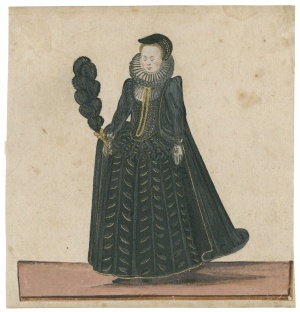Consuming Splendor: Luxury Goods in England, 1580–1680 children's exhibition
This article collects the children's exhibition material featured in Consuming Splendor: Luxury Goods in England, 1580–1680, one of the Exhibitions at the Folger.
A Trip to the First Mall
Between 1580 and 1680 in England, people were buying more and more luxury items, from porcelain bowls to pearls to lace to chocolate. Like the shopping malls of today, the Royal Exchange and the New Exchange in London were places people went to meet friends and see the latest fashions, as well as to shop.
Luxury Scavenger Hunt
This picture shows some luxury goods that were popular in England in 1647. How many different things can you find in this picture?
Now look at the chart of luxury items from seventeenth-century England.
| chocolate | fur | jewels | marble | silk | tea |
| coffee | glass | lace | paintings | silver | tobacco |
| crystal | gloves | lacquered
furniture |
pearls | sugar | velvet |
| fans | illustrated
books |
leather | porcelain | tapestries | watches |
- How many of these are still popular today?
- Do we still think of them as luxury goods?
- Can you find any of them in your home?
Chocolate Recipe
Chocolate was originally a bitter, spicy drink from Latin America. In the 1500s, the Spanish added sugar, cinnamon, and other spices to it.
By the 1650’s, chocolate became a popular luxury drink in England. People started gathering in English coffeehouses, like the one shown here. They drank chocolate and coffee and smoked tobacco. For more on Chocolate, visit All About Chocolate from the Chicago Field Museum.
Try this seventeenth-century recipe for hot chocolate! Ask an adult to help you.
Seventeenth-Century Chocolate
Based on a recipe published in England in 1652[1]
Ingredients:
- 1 ½ tablespoons unsweetened cocoa
- 1 ½ tablespoons sugar
- ½ teaspoon cinnamon
- 1/8 teaspoon cloves
- 1 to 2 drops pure anise extract
- 1 cup milk
- Optional: 1 small dash cayenne (ground red pepper)
Preparation:
Mix all the dry ingredients together in a bowl. Set it aside.
Pour the milk into a small pan. Stir in the cocoa mixture and anise extract. With an adult’s help, heat the milk until steaming, while continuing to stir.
(Or, you can pour the milk into a mug and heat it on high in the microwave for 1 ½ minutes. Then stir in the cocoa mixture and anise extract.)
Makes one cup of chocolate.
Design a Shop
In seventeenth-century England, shops had signs hanging overhead that made it easy for shoppers to find them. If you wanted to shop at “Mary Long’s at the Sign of the Rose,” for instance, you would look for a sign with a picture of a rose. The names and signs did not always relate to what the shop sold. For example, The Blue Anchor was a bookshop.
Shops also gave out tokens, like the ones pictured here. People could use these like coins to buy things, but they also helped advertise the shops.
Design your own shop!
- What will you call your shop? Draw a shop sign that goes with the shop’s name.
- What luxury goods will you sell?
- What will your shop look like? Draw a picture.
- Design tokens to advertise your shop.
Fashion, Then and Now

When people in seventeenth-century England had their portraits painted, like the one shown here, they made sure to wear fancy clothes and jewelry. They often wore bright colors and fine fabrics like silk and velvet. This showed their good taste, wealth, and status.
Check out some modern fashions.
- What do people wear to show their wealth, status, and taste today?
- What do their clothes say about them?
- How have fashions changed since the 1600’s?
- Has anything stayed the same?
Luxuries from Around the World
In the 1600s, people in England wanted to buy things from all over the world, like glass from Venice, lace from Flanders, and porcelain from China.
King James I wanted people to learn to make luxury items like silk, glass, and tapestries in England instead of buying them from other countries. (This scene shows women making silk.)
Where do the things in your home come from? Look at 15 items you have in your home. Where were they made? Finish the following sentences.
- ________ things were made in my country.
- ________ things were made in other countries.
- ________ things were made in Africa.
- ________ things were made in Asia.
- ________ things were made in Europe.
- ________ things were made in Central or South America.
- ________ things were made in North America.
- ________ things were made in other places.
- More things were made in ________ than in any other country.
Do it Yourself
When people could not buy the luxury goods they wanted, they sometimes learned how to make them themselves. Books showed them how.
In 1674, Hannah Wooley wrote a book that taught people to make luxury items they could not afford, like wallpaper and fake feathers!
In the mid-1600’s, it became harder for England to trade with China and Japan. The book A treatise of japanning and varnishing by John Stalker and George Parker, published in 1688, taught people how to make their own Japanese-style boxes and furniture. The books had patterns people could copy.
Try making your own origami box using Japanese patterns.
Notes
- ↑ Adapted from: Chocolate, or, An Indian drinke by the wise and moderate use whereof, health is preserved, sicknesse diverted and cured, especially the plague of the guts, vulgarly called the new disease ... / written originally in Spanish, by Antonio Colminero of Ledesma ... ; and faithfully rendred in the English by Capt. James Wadsworth., London: Printed by J.G., 1652.